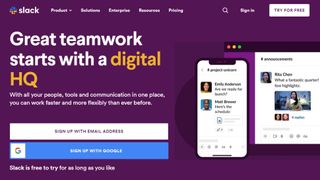Best Microsoft Teams alternative of 2024
Our rundown of the best Microsoft Teams alternatives on the market
The best Microsoft Teams alternatives make it simple and easy to improve productivity without paying for a Microsoft license.

1. Best overall
2. Best for ease-of-use
3. Best for large conferences
4. Best for messaging
5. Best dial-in support
There are plenty of video conferencing services on the market beyond just Microsoft Teams. Te best Teams alternatives provide a great way for individuals and businesses to engage in remote collaboration and communicate with colleagues, teachers and loved ones when face-to-face meetings aren’t possible.
Since the start of the pandemic, video conferencing tools like Microsoft Teams have experienced a sharp uptick in popularity. Competition between the different solutions has been fierce, with developers rushing to launch new features that will boost productivity and make their platform the remote working tool of choice.
But while Teams has certainly built up a formidable reputation, there are plenty of other solutions that are proving similarly popular.
Below, we take a look at some of the best Teams alternatives that will ensure your employees remain connected and productive wherever they are based.
We've also listed the best Microsoft Office alternatives.
The best Microsoft Teams alternatives of 2024 in full:
Why you can trust TechRadar
Best overall

Reasons to buy
Reasons to avoid
Zoom is our number one pick for the best Microsoft Teams alternative. It has all the key features that businesses need and boasts some competitive pricing plans that will entice organizations large and small.
Perhaps even more so than Teams, Zoom has become synonymous with the sudden increase in the popularity of video calls. In fact, its name even became attached to unwanted interjections to these calls, with “Zoombombing” entering the popular lexicon (until businesses started to improve the security around their remote meetings).
Zoom comes with HD video and audio calling, screen sharing, virtual backgrounds, and local storage for recorded meetings. Paid plans increase the features on offer, providing cloud storage, live audio transcription, and advanced meeting analytics via the admin portal. If Teams simply isn’t for you, then Zoom represents a fantastic alternative.
Read our full Zoom review.
Best for ease-of-use

Reasons to buy
Reasons to avoid
Although some video conferencing tools can be more difficult than others to get to grips with, that’s certainly not the case with Google Meet. The program, which can be accessed through your web browser, couldn’t be easier to use. Individuals simply click a meeting link (or send an invite through Gmail), and they are ready to go. There’s no need to download a bespoke application or worry about whether your device is compatible with the software.
In terms of its feature list, much depends on whether users have a Google Workspace subscription. If they do, Google Meet will provide support for up to 150 meeting participants, and grant users access to an unlimited number of meetings at a maximum of 24 hours per meeting. Having said that, the free version is also pretty generous, and without a Google account still allows for up to 100 participants to join your meeting. You’ll need a Workspace subscription if you want to invite non-Google account holders, however.
Security is another area where Google Meet performs well. All data is fully encrypted and meeting participants need an invite and a meeting link to join, or a meeting PIN if they are dialing in using their telephone. For added security, meeting hosts can also set up two-step verification.
Read our full Google Meet review.
Best for large conferences

Reasons to buy
Reasons to avoid
If you're looking for the best Teams alternative for large-scale conferences, then Webex is the solution to go for. You might also want to download Cisco Webex Productivity Tools, which will help you to manage your invitation and agenda processes for larger gatherings. The tools will also allow integrations with Microsoft Office, Outlook and Teams.
For bigger organizations, Webex’s Enterprise tier pricing plan is likely to prove attractive. It is priced on a bespoke basis, so businesses will need to contact a Cisco rep, but it comes with features that will be difficult to find from other video conferencing tools. For example, you’re granted an unlimited number of hosts, the option of having up to 100,000 meeting attendees, and given an unlimited amount of cloud storage for recorded video meetings.
Of course, most companies won’t need to host such large meetings, but it’s nice to know that you’re unlikely to ever outgrow Webex. Plus even smaller players will benefit from personalized screen designs, the AI-powered Webex assistant, and a collaborative digital whiteboard.
Read our full Webex Meetings review.
Best for messaging

Reasons to buy
Reasons to avoid
Initially, businesses could be forgiven for thinking that Slack is simply a useful messaging tool - and, certainly, it excels in this area. But there’s a lot more to this program as well. It boasts a straightforward and easy-to-use interface and a good mix of simple and more advanced features. In fact, Slack offers roughly 2,000 apps that enable users to greatly extend its functionality, as well as integrations with the likes of Google Drive and Trello.
In terms of pricing, Slack offers a free option, as well as two paid tiers - Pro, which costs $8 per user per month, and Business+, which will set firms back $15 per user per month. Admittedly, the video and audio calling functionality that comes with Slack is inferior to that found in other video conferencing solutions but there is a multitude of other features to make up for it.
Read our full Slack review.
Best dial-in support

5. RingCentral
Reasons to buy
Reasons to avoid
While RingCentral may be better known for its VoIP solutions, it also provides a pretty serviceable video conferencing solution. In fact, RingCentral’s VoIP pedigree is clear to see in the way that its video solution offers so much compatibility with traditional desk phones. For example, there’s dial-in support for all plans, the ability to dial out to join a conference, and there’s a Call Me function, which gets the service to dial your phone and connect you into the meeting instead of having to use one of the provided phone numbers.
Read our full RingCentral review.
Get in touch
- Want to find out about commercial or marketing opportunities? Click here
- Out of date info, errors, complaints or broken links? Give us a nudge
- Got a suggestion for a product or service provider? Message us directly
- You've reached the end of the page. Jump back up to the top ^
Are you a pro? Subscribe to our newsletter
Sign up to the TechRadar Pro newsletter to get all the top news, opinion, features and guidance your business needs to succeed!
Barclay has been writing about technology for a decade, starting out as a freelancer with ITProPortal covering everything from London’s start-up scene to comparisons of the best cloud storage services. After that, he spent some time as the managing editor of an online outlet focusing on cloud computing, furthering his interest in virtualization, Big Data, and the Internet of Things.

